What most don’t realize is, there are numerous other combat jobs that you can join up with.
While they don’t necessarily share the prestige and exposure that SEALs do, they are nevertheless an important part of the Navy’s overall mission.
Here are 5 of the best combat jobs in the US Navy.
Table of Contents
5. VBSS (Visit, Board, Search, Seizure Team)
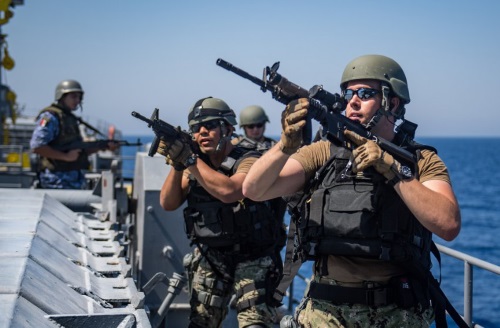
Note: Click Here to read our full article on VBSS.
One of the most well-known combat jobs (if you can really even call it that) is Visit, Board, Search, Seizure, otherwise known as VBSS.
VBSS teams do exactly what it sounds like; they visit ships, board them, search them, and in some cases seize them.
This is an essential mission in certain areas of the world, including the Persian Gulf, the Gulf of Aden, and the Arabian Sea.
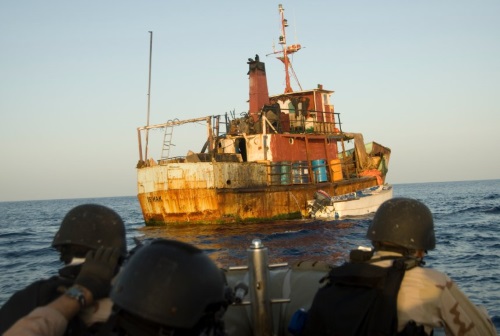
Most VBSS teams in the Navy are made up of a variety of onboard personnel.
The thing that differentiates them from the other combat jobs in the Navy is that it’s not actually its own rating.
When you serve on a VBSS team, you do so essentially as a volunteer.
While not operating in the capacity of a VBSS team, you’ll be doing whatever your full-time rating and/or job is.
That could be everything from an electrician’s mate to a hull technician.
A typical day in the life of a VBSS team member might include boarding a ship, examining their cargo and logs, and questioning crew members.
Because of the nature of their mission, VBSS team members receive hazardous duty pay in addition to their normal pay.
4. Seabees
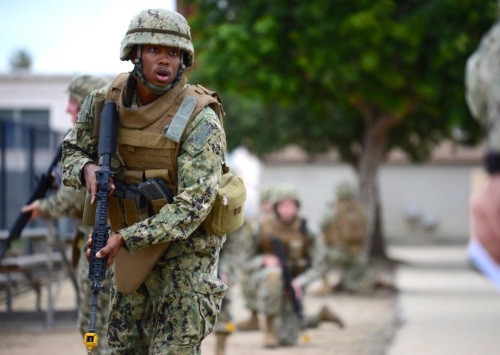
“We build, We fight”
That’s the official motto of the US Navy Seabees, a branch of the Navy that doubles as both builders and soldiers.
Officially known as Naval Construction Battalions (CBs, get it?), Seabees are another one of the best combat jobs you can have in the Navy.
They are divided up into 7 occupational field ratings:
- Builder (BU)
- Construction Electrician (CE)
- Construction Mechanic (CM)
- Engineering Aide (EA)
- Equipment Operator (EO)
- Steelworker (SW)
- Utilitiesman (UT)
Their primary mission is to construct and maintain American military bases around the world, as well as support humanitarian efforts in war-torn regions.
As a result, they are often in direct contact with enemy forces.
They are essentially trained both as builders, as well as combat soldiers.
After Navy boot camp, Seabees get their training at Port Hueneme, CA, Naval Construction Battalion Center Gulfport, MS, Fort Leonard Wood, MO, or Sheppard AFB, TX. The length of training varies according to the specialty.
The life of a Seabee can be both rewarding, as well as exciting, making it one of the most sought-after jobs the Navy has to offer.
Additionally, the skills you learn as a Seabee can directly translate into many civilian jobs.
Related Article: 10 Best Navy Jobs For Civilian Life
3. Hospital Corpsman (HM)
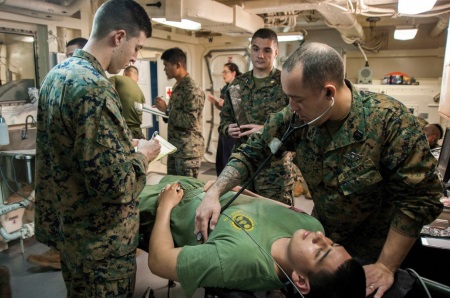
Note: Click Here to read our full article on Navy Hospital Corpsman.
If you’re looking to be in the thick of it on the battlefield, then becoming a corpsman will get you there.
They are the most highly awarded and decorated rate in the United States Navy.
Enlisted personnel can pursue the HM rating with a minimum Armed Services Vocational Aptitude Battery (ASVAB) combined test score of VE+MK+GS=156.
Just like the other enlisted rates, applicants must have a high school diploma or equivalent.
Related Article: Which Branch Of The Military Should I Join?
There are 38 different medical specialties to choose from when becoming a corpsman, but two, in particular, see the most combat — Field Medical Service Technicians and Special Amphibious Reconnaissance Corpsmen (SARC).
Field Med Techs provide basic life support and perform minor surgical procedures and routine emergency care for Marines during reconnaissance operations.
The Marine Corps does not have its own medics, so they rely on the Navy for all medical care needs.
Fleet Marine Force (FMF) corpsmen are trained for the battlefield.
Those that work with Marines are considered “green side,” while “blue side” corpsmen work on ships, in hospitals, or in clinics.
SARCs work at Joint Special Operations Command (JSOC) and Marine Corps Special Operations Command (MARSOC).
They are generally attached to Marine Recon units or attached to U.S. Special Operations Command (USSOCOM).
They possess paramedic skills to provide immediate advanced medical support and emergency medicine.
SARCs train to become operational members of recon or MARSOC teams.
They go through intensive pipeline training which includes diving, parachuting, advanced swimming, and small/large ammunition handling.
SARCs are also trained to operate hyperbaric chambers which they learn to recompress for hyperbaric treatment.
Among other responsibilities, they also perform routine sick calls, diagnostic patient care, logistics duties, minor surgical procedures, and basic radiology.
2. Special Warfare Combatant-Craft Crewmen (SWCC)
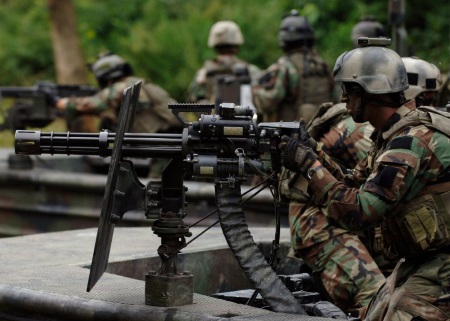
SWCC provide vital mission support to the Navy SEALs, but they aren’t actually SEALs themselves.
Related Article: 9 Ways To Check If Someone Was A Navy SEAL
They operate high-performance boats, protect the waters from enemy combatants globally, and are overall a part of an elite team that carries out special operation missions.
Additionally, SWCCs conduct some of their own special reconnaissance missions. Some of the various duties you may perform as a SWCC include:
-
- Inserting and extracting SEALs and spec ops personnel from various Naval Surface Warfare vessels.
- Collecting critical data about enemy military installations, performing direct action raids, and providing rapid mobility in shallow waters where larger ships cannot operate.
- Operating and maintaining ordnance systems, communications, electronics, small boats, and other equipment associated with SWCC and other Special Warfare missions, and assisting other law enforcement agencies.
Navy SWCCs can be either enlisted personnel or warrant officers. Senior enlisted SWCC operators with years of experience may apply for commissioning as Chief Warrant Officers (CWO).
If you are a civilian and want to become a Navy SWCC operator, talk to your local Navy recruiter. If you are currently in the Navy, speak with your Command Career Counselor, LPO, or LCPO.
You can also contact the SEAL and SWCC Scout Team for more information.
1. Sea, Air, and Land Forces (SEAL)
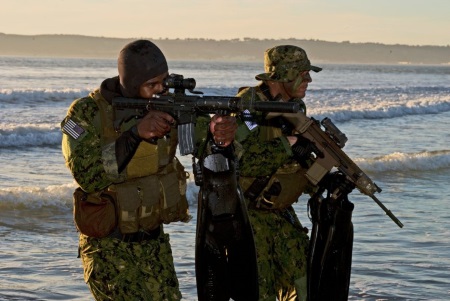
No combat jobs in the Navy list would be complete without a mention and discussion of the Navy’s primary special operations force: The US Navy SEALs
A Navy SEAL can be either enlisted or an officer, depending on the number of responsibilities and leadership roles you want to put yourself in.
SEALs conduct missions behind enemy lines and capture enemy targets and gather intelligence using superior weapons and tactics.
They are members of the Naval Special Warfare (NSW) community who take on the most seemingly impossible missions and objectives.
Related Article: DEVGRU: Selection, Squadrons, Gear, Notable Missions, And More
Navy SEAL training is considered to be the most physically and mentally demanding in the military.
Responsibilities include insertions and extractions by sea, air, or land to complete covert Special Warfare missions, capturing high-value enemy personnel, collecting intelligence through reconnaissance, carrying out direct-action missions, and performing underwater recon and demolition of natural or man-made obstacles to allow safe amphibious landings.
Their motto says it all, “The only easy day was yesterday.”
Bonus Combat Job – EOD Technician
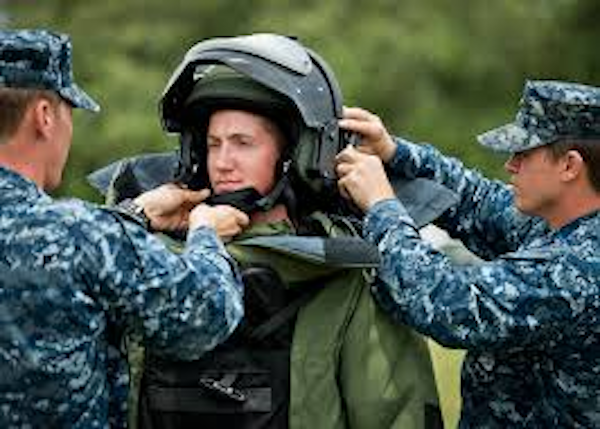
One other Navy job that is technically a combat job would be Explosive Ordnance Disposal Technicians, or EOD.
These are the guys you see dressed up in those bulky suits, faceplates, and other clunky gear.
They are responsible for the safe disarmament and disposal of explosives, and it can be a very “nail-biting” job.
With that said, they are highly trained experts that keep their cool under pressure.
EOD technicians work alongside most special operations forces, including Navy SEALs, Army Rangers, and even Air Force PJs.
Click Here to learn more about Explosive Ordnance Disposal technicians in our full career guide.
Conclusion
As you can see, there are plenty of combat jobs in the Navy that don’t demand you to go through the rigors of BUD/S (the training requirement for SEALS).
There are actually several other jobs in the Navy that are considered combat-related, but these are the only ones that involve on-the-ground operations.
If you’re thinking about enlisting and want to be involved in the action, definitely talk to your recruiter about one of these career choices.
Related Article: 41 Questions To Ask A Military Recruiter
- Navy Signing, Enlistment, and Reenlistment Bonuses - June 19, 2024
- Navy Health Professions Scholarship Program (HPSP) Guide - June 19, 2024
- Navy Nurse - June 19, 2024
Originally posted on February 11, 2019 @ 5:33 pm
Affiliate Disclosure: This post may contain affiliate links. If you click and purchase, I may receive a small commission at no extra cost to you. I only recommend products I have personally vetted. Learn more.

can you travel around the world if you join the navy ?
Not sure I understand your question. You will certainly travel the world after joining the Navy, but you likely won’t have much of a choice of WHERE you’ll be going.
Depends on if your on the water or under. My son is stationed in Connecticut they go out to sea but since he is a submariner not many ports can support their boat.
Someone forget to tell my bosses that Navy EOD was “technically a combat job”. In Battle of Fallujah, Battle of Sadar City, and after personally 7 combat deployments to Iraq, Afghanistan, and Syria my bosses differently forgot to tell me I was technically a combat job. Maybe after 3 Bronze stars “V”, ARCOM “V” 3 purple hearts and little over 300 combat missions, they will finally let me know that I have combat job. I think I need to change to a real combat job…one listed above.
One other combat job in the Navy which does occasionally participate in “on-the-ground operations” that was not discussed here is that of Cryptologic Technician. Given the nature of this job, it is understandable why, but it is something that one should consider if looking into a job in the Navy in which seeing combat is a possibility.
Cryptologic Technician – Collections Petty Officer 1st Class Michael Strange served with a SEAL team in Afghanistan in 2011. His job was to monitor and alert the SEALs during their raids to any “squirters” – enemy combatants attempting to flee the battlefield – so that the SEALs could prevent their escape. Due to the “hit and run” nature of attacks by the Taliban on Coalition forces in Afghanistan, this job was very important: the guys who are shooting at you today, if allowed to escape, are only going to shoot at you again tomorrow. Sadly, CTR1 Strange was killed when the helicopter he was in was hit by an RPG in August 2011, in what would become the single-deadliest incident for Coalition forces in Afghanistan with 29 US servicemembers and 8 Afghans KIA. But his experience shows just how close to the action some Navy CTs can get.
Cryptologic Technician – Interpretive Senior Chief Petty Officer Shannon Kent was a Navy linguist trained in Arabic, who was serving with a joint special mission unit in Syria in early 2019, during the last phase of the campaign to wipe out ISIS’ territorial holdings in northern Syria. She was on an intelligence-gathering mission when a suicide bomber blew himself up in a café in which her team was trying to meet an informant – killing her and her three compatriots. Although not specifically going into combat per se, CTICS Kent was extensively combat-trained, deployed in-country to active conflict zones, and had a record in Naval expeditionary warfare that impressed all of her colleagues. The headquarters of the US Navy detachment at the Defense Language Institute in Monterey, CA, where Navy linguists such as CITCS Kent are initially trained in a foreign language, has been named in her honor.
There are technically 5 different types of Navy Cryptologic Technicians (collection, interpreter, maintenance, technical, and networks) and theoretically, all of them have the opportunity to deploy into combat zones if selected for special assignments. Unfortunately for those wanting to research the job, outside of the two above examples, there is very little made public about the CT community vis-à-vis combat deployments, so exactly how many and how frequently CTs deploy in this manner is largely unknown. Due to the sensitive nature of their work, CTs are a notoriously tight-lipped community, so the public is largely only going to hear of stories of CTs’ combat-related exploits when something like the above happens – and they pass away notably on assignment. Many Navy recruiters do not even know extensive specifics of a CT’s job. While the recruiting pamphlet you can pick up in the US Navy office at your local Armed Forces Career Center is going to say that Cryptologic Technicians tend to work in office environments or in small rooms filled with high-tech equipment aboard ships – and many do – the little-known reality is that CTs actually have a diverse career path which can give them the opportunity to deploy on unique assignments in and around combat zones, so could still be deemed an “on-the-ground” operations job in the US Navy.